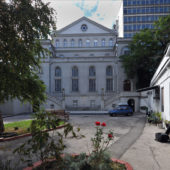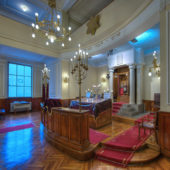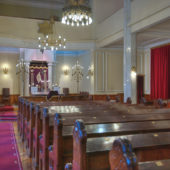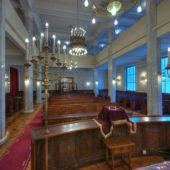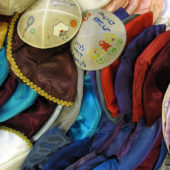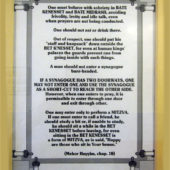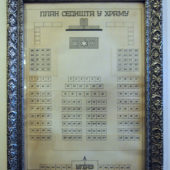The only fully functional synagogue in Serbia.
Jews first arrived in what is now Serbia approximately 2,000 years ago. They became particularly important in the salt trade. Centuries later, Jews fled the Spanish and Portuguese empires in 1492 and 1498 and found sanctuary in the Ottoman-ruled areas, including Serbia. By the 19th century Jewish merchants were predominantly responsible for the trade routes between the Ottoman Empire’s northern and southern territories. Jewish communities flourished in Serbia until WWII, when they were mostly annihilated (some Jews were fortunate enough to have fled to other countries for refuge). After the Holocaust, of the few Jews that returned to Serbia, many subsequently emigrated, often to Israel or to the United States. Some assimilated, losing their Jewish identity. In the 1980s, approximately 2,500 Jews lived in Serbia, predominantly in Belgrade. By 2002, the Serbian census revealed that the number of Jews had decreased to 1,185, most of whom lived in Belgrade and Vojvodina (in northern Serbia).
The only remaining, functioning synagogue in Serbia is the Belgrade Synagogue, otherwise known as “Kosmajska Temple.” The Society of Ashkenazi Jews of Belgrade bought land on what was once Kosmajska Street, and is now Marsala Birjuzova Street. On June 15, 1924 there was an elaborate ceremony in honor of the laying the cornerstone, within which a charter containing texts in both Hebrew and Serbian was sealed. The charter was signed by King Alexander and Queen Maria of Yugoslavia. Construction was completed on November 1, 1925 and once the interior had been finished, the Synagogue was open for worship in the summer of 1926 and consecrated by Rabbi Schlang.
The official plans indicated that the Synagogue building was to incorporate a mikvah (ritual bath), a school, community offices, meeting rooms, and apartments for the community employees. There is also a community room for the youth and a kindergarten. The Synagogue houses many families affiliated in some way with the local Jewish community. Traditionally, this Synagogue served Ashkenazi Jews and the services were in Yiddish. However, since the Holocaust, the Synagogue has been serving the entire Jewish community (Ashkenazi and Sephardi), and today there have been more Sephardi Jews than Ashkenazi. Services are held on Fridays and High Holidays. The Synagogue was renovated in 1990 and a major restoration project is planned in the near future.
The Belgrade Synagogue was designed in the grand Neoclassical style (classified as Academic in this part of Europe), with an enclosed accent yard at the front. Row upon row of tall, arched, paned windows, largest at the bottom and becoming increasingly smaller on the second and third floors, adorn the façade, with a round Star-of-David window at the gable of the building. A grand staircase dominates the front of the façade, leading into the entranceway of the Synagogue. Inside the large prayer room, butter-yellow walls with white molding are punctuated by paned windows along the side walls. The women’s gallery runs along the sides and back of the sanctuary, with large white marble columns supporting it, running from the ceiling to the ground floor. Varved wood benches sit on parquet wood floors. From the white coffered ceiling drop several brass, multi-armed chandeliers. The bimah is at the front of the prayer room, behind a wood-paneled balustrade. The Aron Kodesh features gray marble steps, two white marble columns on each side supporting a large white crosshead. Upon this sit two tablets, inscribed in Hebrew with the Ten Commandments. A large tivah (reader’s desk) sits on the platform in front of the Aron Kodesh, with a deep red throw embroidered in gold covering it. Lit menorahs are situated on the bimah. The ceiling just above the bimah is inset and backlit, painted light blue with gold stars. There is a large inscription on the crossbeam just above the entrance to the bimah, gilded in Hebrew.

